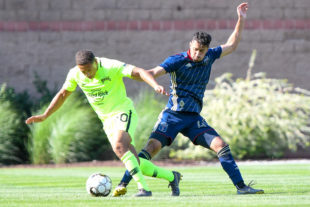Feature photo courtesy Marjorie Elzey
Major League Soccer and the Major League Soccer Players Association will negotiate a new Collective Bargaining Agreement this coming offseason. The current CBA expires in seven months on January 31, 2020.
An issue they should discuss is emergency upward mobility for an MLS organization’s field players playing in USLC or USL1.
Downward mobility is already in place. Philadelphia Union and Bethlehem Steel FC fans know first-teamers get game minutes with the USLC team, whether for injury rehabilitation or general experience. And those who are true roster detail junkies know that, for goalkeepers, there is a useable mechanism allowing a USLC-rostered player to play in MLS in “extreme hardship,” with extreme hardship being realistically defined.
On paper a similar mechanism for field players exists, but its qualifying condition makes it of little practical use, since it does not differentiate among field player positions. The MLS team must have fewer than 14 total field players available for the hardship provision to apply. In practice, the provision is not useful, since it would be triggered only by a team-wide infectious disease outbreak.
A team is forced to play a striker as an outside back, rather than calling up an outside back from the farm. Issa Rayyan cannot sit the Union bench to back up Ray Gaddis. That retards rather than enhances evaluating player development.
Examples elsewhere
American sports fans know that Major League Baseball has a more effective system.
An MLB roster has 40 slots, 25 of which are active at any one time. The 15 “not-actives,” if healthy and available, can be called up on “options” to play in the majors when needed or wanted. One option can be used several times during its single season, and a player’s option can be exercised for three different seasons before the club must offer the player to others to avoid talent-stultifying hoarding a lathe New York Yankees’ AAA farm team in the early 1950s. (Early fifties Newark was thought to be a much stronger team than the then-Kansas City Athletics.)
While myriad details are different, the National Basketball Association has a roughly similar arrangement with its D League through the 10-day contract system.
No upward mobility
For soccer’s field players during regular season league games, Major League Soccer and the United Soccer League’s Championship and League One do not have the workable rough equivalent of MLB’s option system and the NBA’s 10-day contracts. They have it only for “friendlies” and U. S. Open Cup matches.
MLS clubs cannot put a player into a regular season major league match to see if he can handle it before deciding whether to promote him to permanent major league status. And as various Union and Bethlehem Sporting Directors and coaches have said, games are what matter because practice tells only so much.
The professional game north of the Rio Grande would benefit were the accuracy of player development judgment improved. Amidst all the other details and conflicts of the new CBA, we can only hope each side’s negotiating committees will hammer out better regular season upward mobility in some fashion.


the headline and article don’t seem to match
I came here for a 2nd half low-down, but left with current CBA issues – and am much better off for it now.
.
You always hear about the big issues like flying and base pay, but it’s these smaller things that have a huge impact on the game. Our lower pyramid is developing now (finally!) and it’s cool to see how it’s being built.
Interesting article.
Although, I am not sure what the MLS Players Union would gain?
Their primary motivation is not growing the game. Nor really is MLS’s primary objective growing the game. As a fan of the USMNT, I want to see this though.
Depends on what you mean by the catch-all and inexact phrase, “growing the game”.
I really don’t want to see USL turned into a minor league. The passion of soccer worldwide compared to other American sports is in part because every community has a team who has the goal of competing and representing the community.
.
Is minor league baseball fun? Of course. Is it as fun as watching a lower league team that’s actually trying to win? Absolutely not.
“Turned into a minor league”? What do you think it is? It’s pretty minor, they draw small crowds in secondary/tertiary markets.
Minor league to me means that all teams exist solely as a farm squad for specific major league team.
.
I’d prefer it to be a lower league where most teams are independent and who’s primary goal is to win, not serve as a farm team.
Ok, that’s not what it means though.
Is the MLB 40-man roster vs 25-man active roster what MLS tried to accomplish with the 30-man roster vs game day 18?
.
If so, the ease of downward mobility makes sense. It seems like these rules were written for MLS 1.0, before everyone had USL affiliates, when roster spots 19-30 could be used for your developing prospects. I vaguely remember MLS teams having reserve matches, OchoCinco played in one for SKC reserves while holding out.
.
I think the way it is set up currently can still work, but the complications of international slots makes it a lot harder. MLS teams also probably don’t want to pay players who will likely be spending all year in USL an MLS minimum salary.
Or we just wait until that’s the way LAG wants to handle Galaxy II
.
https://m.imgur.com/iCItzMd?r